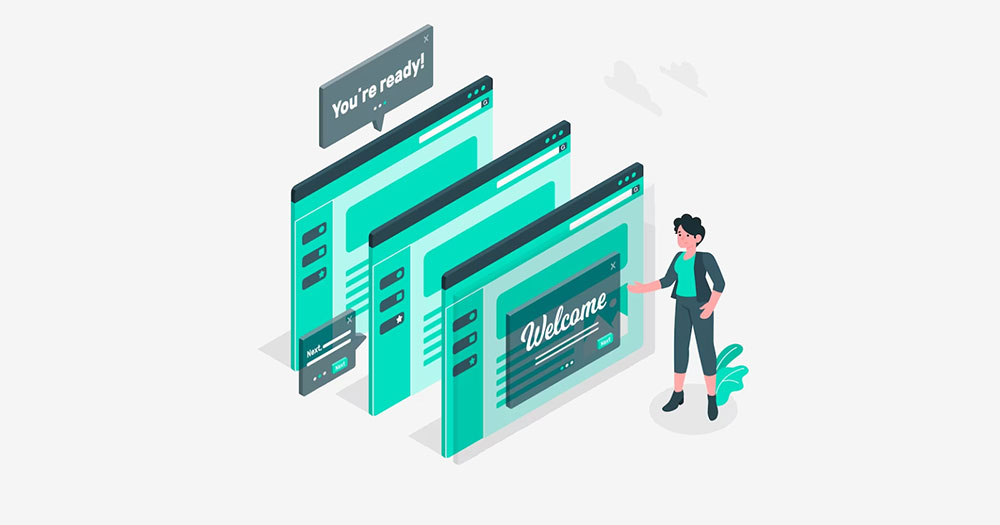Driving Success: Effective User Adoption Strategies

Imagine unfurling a map. You are here—not just to sightsee but to journey through the maze of user adoption strategies. Your compass? A methodical blend of onboarding wizardry and user engagement alchemy that I’ve harnessed over vigorous trial and error.
In the digital sigil of web design, understanding strategies for seamless user adoption equals power.
We don’t just launch platforms; we nurture environments where users plant roots and flourish. That’s a tale as old as the internet, reframed for the modern e-landscape.
By article’s end, expect a treasure trove of tactics gathered from the front lines—how to sharpen your user engagement techniques, make onboarding processes your ally, and weave those feedback mechanisms into pure gold.
You’ll walk away equipped with cutting-edge implementation best practices and a new understanding of the user experience optimization necessary for cementing avid, lifelong users. Be ready to transform your site into a beacon of adoption with these user-centric design insights.
Is your curiosity piqued? Good. Let’s dive into the depths of cultivating digital ecosystems where users not only visit but stay, engage, and thrive.
Key takeaways
- Goal Setting and Metrics: Start by setting a clear goal that aligns with business objectives and user adoption strategies. Selecting the right metrics and implementing a tracking plan are crucial for measuring progress and making data-driven decisions.
- Importance of Training and Tools: Training plays a central role in user adoption, acting as a guide to help users learn and master the product. Utilizing tools like interactive walkthroughs and in-app guides can also aid in this process.
- Addressing User Resistance: Overcoming resistance among users involves empathy and clear communication. It’s important to understand their concerns, demonstrate the product’s benefits, and ensure support is available throughout their journey.
- Continuous Engagement and Feedback: Maintaining user engagement over time requires regular updates and responsiveness to feedback. It’s essential to listen to users and iteratively refine the product to enhance their overall experience.
Understanding User Adoption
But how do we understand this beast called user adoption? Is there a map or a guide to it? Absolutely, and that’s what we will explore in this section.
The User Adoption Process
Imagine your user is on a journey. They’re at the beginning of the path, and your product is at the end. Now, you need to guide them to your product, help them understand its benefits, and make them see why they should adopt it. This journey is the user adoption process.
It’s a multi-step process:
- Awareness: Users become aware of your product.
- Interest: They show some interest in what you’re offering.
- Evaluation: They evaluate your product against others.
- Trial: They try your product to see if it meets their needs.
- Adoption: They fully integrate your product into their routine.
It’s like a marathon, not a sprint. It takes time, effort, and a whole lot of understanding your users.
Key Metrics in User Adoption
It’s not enough to just set up a user adoption process, we need to measure how well it’s working. And that’s where key metrics come in.
These are some of the signals that tell us if our users are on the right path. How often are they logging in? Are they using the features we think are most important? How many of them are returning? These are the kind of questions these metrics answer.
And it’s not just about numbers. These metrics help us understand our users better, their behaviors, their needs, their pain points. So, it’s like having a conversation with them, without actually talking.
The Impact of User Adoption on Business Metrics
Now you might be wondering, why do we care so much about these user adoption metrics? Because they have a direct impact on business metrics.
Think about it. If more users are adopting your product, more of them are paying for it. That means more revenue. Plus, they’re more likely to stick around, which means lower churn rates. They might even recommend your product to others, which means free marketing!
So, user adoption strategies are not just about users. They’re about the overall health of your business.
Strategies for Improving User Adoption

Creating an incredible product is just the first half of the game.
The next half?
Getting users to embrace your product. Buckle up, because I’m going to share some user adoption strategies that can help you do just that.
Making Onboarding a Continual Process
A common mistake? Thinking onboarding is a one-time event.
Nope!
It’s a continual process. You’ve got to be with your users every step of the way, helping them navigate the product.
The Importance of Continuous Onboarding
Continuous onboarding is like a tour guide who doesn’t leave your side until you’re confident enough to explore on your own. This helps users get comfortable with the product and see its value over time, which can lead to increased user adoption.
Adapting Onboarding to Different Types of Customers
Every user is unique, so why should the onboarding process be the same for everyone? Tailoring the onboarding experience to different user types helps them find value quickly, boosting user adoption.
Going Beyond UI Design Patterns
Designing an intuitive user interface is crucial, but it’s not the only ingredient in the user adoption recipe. The next two strategies delve deeper.
Importance of UI Design Patterns
Recognizable UI design patterns make users feel at home in your product. They know where to click, what to expect. It eases their journey, aiding user adoption.
The Role of Contextual Content
Contextual content is like breadcrumbs on the user journey. It’s tips, hints, or information right when users need it.
It helps them understand how to use a feature or what a button does, making the journey smoother and fostering user adoption.
The Importance of Contextual Communication
Don’t just talk to your users, converse with them. Send relevant, timely messages based on their interactions. This makes them feel heard and understood, making them more likely to adopt your product.
Identifying Activation Criteria
Activation criteria are like milestones on the user journey. They signify that a user has found value in your product, making them more likely to adopt it.
Understanding Activation Criteria
These criteria are actions that indicate that a user is getting value from your product. For example, for a music app, an activation criterion could be creating a playlist.
Examples of Activation Criteria in Well-Known Companies
Different companies have different activation criteria. For Dropbox, it could be uploading a file. For Slack, it could be sending a message. Understanding these can help you define your own and drive user adoption.
Organizing Efforts Around Areas of Business Value
Now let’s talk about aligning your efforts with areas that drive value for your users and your business. It’s like focusing your energy where it matters the most.
Understanding the C.A.R.E Model
C.A.R.E stands for Customers Are Really Everything. This model suggests that you should center your strategies around customer needs and experiences. It’s all about ensuring your users feel valued and understood, which in turn can lead to increased user adoption.
Applying the C.A.R.E Model in Onboarding
When you apply the C.A.R.E model to your onboarding process, you create a personalized experience that directly speaks to the needs of your users. It’s like telling them, “Hey, this product was built with you in mind”. And when users feel that, they’re more likely to adopt your product.
Using Retention as an Exercise in Proactivity
Retention isn’t just about reacting to users who are about to churn. It’s about being proactive and keeping them engaged so they don’t even think about leaving.
Understanding the “Danger Zone”
The “Danger Zone” is when a user hasn’t interacted with your product for a while. It’s a red flag, indicating they might churn. Identifying this zone allows you to act before it’s too late.
Strategies to Prevent Users from Entering the “Danger Zone”
Keep your users engaged with regular, personalized communication. Show them new features they might like, remind them of unused features, and always make them feel valued. This can help keep them out of the “Danger Zone” and boost user adoption.
Making the Onboarding Period Ring-Fenced
The onboarding period is a critical time in the user adoption journey. It’s when users are trying to figure out if your product is a good fit for them.
The Importance of Focused Communication During Onboarding
During onboarding, your communication with users should be laser-focused. You want to guide them, help them discover value, and reassure them they made the right choice. This can help drive user adoption.
Driving Behaviors that Trigger Conversion and Activation
The goal during onboarding is to drive behaviors that trigger conversion and activation. Get them to try key features, engage with the product, and see the value. This sets the stage for user adoption.
Avoiding Working in Onboarding Silos as You Grow
As you scale, it’s crucial to avoid onboarding silos. It’s about ensuring everyone on your team is aligned and working towards the same goal: boosting user adoption.
The Risks of Onboarding Silos
When different teams are working in silos, the user experience can get disjointed. This can lead to confusion for users, impacting user adoption.
The Benefits of an Onboarding Team
An onboarding team ensures a unified, seamless experience for users. They’re the conductors of the onboarding orchestra, making sure every instrument plays in harmony to create a symphony that leads to user adoption.
Measuring the Success of a User Adoption Strategy
Now that we’ve gone through some top-notch user adoption strategies, how do we know if they’re working?
Just like you wouldn’t know if your fitness plan is working without stepping on the scale, we need to measure the success of our strategies. Let’s see how we can do that.
Choosing a Goal
Every great endeavor starts with a goal. Maybe you want to increase the number of active users, or perhaps you’re aiming to reduce churn rates.
Choose a goal that aligns with your business objectives and user adoption strategies.
Selecting Metrics
With your goal in mind, it’s time to pick some metrics. These are the numbers that will tell you if you’re moving towards your goal or not.
It’s like the markings on a measuring tape, they tell you how much you’ve progressed.
Implementing a Tracking Plan
Once you’ve picked your metrics, set up a tracking plan. It’s about deciding what data to collect, how often, and how to analyze it.
It’s like setting up a fitness tracker. It keeps an eye on your progress and gives you insights into how well your strategies are working.
Recording Baseline Metrics
Before you kick off your strategies, record your baseline metrics. These are your starting numbers. They’re like the ‘before’ photo in a weight loss journey.
It gives you something to compare your progress with.
Making Changes Based on Metrics
As you start implementing your strategies, keep an eye on your metrics. If they’re improving, you’re on the right track. If not, you may need to tweak your strategies.
It’s all about adaptability.
Reviewing and Measuring Again
Finally, remember to regularly review and measure your metrics. Success in user adoption, like in any other field, requires continuous effort and improvement.
FAQ On User Adoption Strategies
What exactly are user adoption strategies?
They’re game plans, right—tactical maneuvers. Designed to get folks comfortable, savvy, even excited about your shiny new system or application. Think change management. It’s way more than a friendly welcome email; it’s a full spectrum of moves from onboarding to user training.
How do you measure the success of these strategies?
Get this: it’s all about the metrics. Dig into adoption metrics like active users, proficiency levels, maybe even net promoter scores. They don’t just count logins, either. You’re eyeballing user engagement—that golden ticket to knowing if they’re really using the tool.
What role does user experience play in adoption?
It’s huge! Imagine a tool that’s clunky to use; even killer features won’t save the day. The trick is in user experience optimization—making everything click into place, intuitive, even enjoyable. User-centric design, my friend, is the silent hero of adoption narratives.
Can user adoption impact overall business outcomes?
Spot on—user engagement and adoption can make or break productivity gains, innovation, bottom lines. It’s like when your team truly jives with the tech, that’s when magic happens. Efficiency soars, customer satisfaction follows, and guess what? That reflects in your revenue.
What common challenges are faced during user adoption?
Challenges? Brace for impact. Resistance to change is numero uno. You’ll also grapple with insufficient training, maybe even skepticism over the need for new tools. Overcome these with clever change management tactics and some onboarding process wizardry, and you’re golden.
How does one create effective user adoption strategies?
Listen closely—best practices are your friends. Start with defining clear goals, involve stakeholders early, and tailor your training programs. Remember, a dash of personalization here, some well-deployed feedback mechanisms there, and voilà, you’re cooking with gas.
What’s the importance of customer feedback in user adoption?
Feedback is the secret sauce. It gives you the real dirt—what’s working, what’s a flop. Dial in those feedback mechanisms, maybe through surveys, user sessions. Take that intel, adjust, improve. Now you’re not just guessing; you’re precision-targeting user experience issues.
How does one tackle resistance during the adoption process?
Resistance, the old foe. Easiest way? Communicate, communicate, communicate. Show the why, the how, the ‘what’s in it for me?’. Get your change management consultants in the ring early, whip up enthusiasm, offer solid user support systems, and resistance crumbles.
Should user adoption strategies vary based on the audience?
Bet your bottom dollar. Tailoring to your audience is key—you wouldn’t talk to programmers and marketers the same way, right? Each group’s got their own vibe, preferences. User behavior analysis, that’s your guiding star here to customization nirvana.
What future trends do you see impacting user adoption strategies?
Algorithms are getting smarter, UX is king, and users? They’ve got expectations sky-high. Keep your eye on AI, machine learning, even VR training modules. These aren’t just buzzwords; they’re the new instruments in the digital transformation concerto we’re all playing.
Conclusion
So, we’ve navigated the intricate web of user adoption strategies, right? Layered them with onboarding wizardry and spun those feedback mechanisms into gold. We’ve dissected how they mold the spine of successful digital voyages.
Now, let’s recap—strategies are the backbone here:
- Tailor the experience, always. The one-size-fits-all fable? Forget it.
- Metrics, they’re the silent narrators of your journey’s unfolding story.
- User-centric design whispers in your ear, nudging you towards an intuitive UI.
Wield these tools with finesse, and watch the landscape shift. Users will become champions, talking up your system like it’s the hot new thing in town.
Final thought? That sturdy bridge from mere usage to genuine commitment? It’s built on embracing change, on knowing the pulse of your audience. Hold these truths close to your heart. Sail forth, wiser, ready to sculpt experiences that stick around for generations of clicks.
If you liked this article about user adoption strategies, you should check out this article about product validation.
There are also similar articles discussing product monetization strategies, product branding, product-led onboarding, and product documentation.
And let’s not forget about articles on product-led sales, product iteration, PLG vs SLG, and product management with Monday.
- Top 7 Ways Outsourcing eCommerce Customer Service Can Increase Your Sales - May 5, 2024
- Animate with Ease: Top CSS Animation Libraries Today - May 5, 2024
- Golang’s Growing Use: What is Golang Used For? - May 5, 2024








